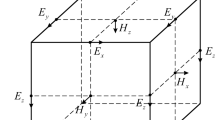Abstract
A finite element algorithm combined with divergence condition was presented for computing three-dimensional(3D) magnetotelluric forward modeling. The finite element equation of three-dimensional magnetotelluric forward modeling was derived from Maxwell’s equations using general variation principle. The divergence condition was added forcedly to the electric field boundary value problem, which made the solution correct. The system of equation of the finite element algorithm was a large sparse, banded, symmetric, ill-conditioned, non-Hermitian complex matrix equation, which can be solved using the Bi-CGSTAB method. In order to prove correctness of the three-dimensional magnetotelluric forward algorithm, the computed results and analytic results of one-dimensional geo-electrical model were compared. In addition, the three-dimensional magnetotelluric forward algorithm is given a further evaluation by computing COMMEMI model. The forward modeling results show that the algorithm is very efficient, and it has a lot of advantages, such as the high precision, the canonical process of solving problem, meeting the internal boundary condition automatically and adapting to all kinds of distribution of multi-substances.
Similar content being viewed by others
References
HOHMANN G W. Three-dimensional induced polarization and electromagnetic modeling [J]. Geophysics, 1975, 40(2): 309–324.
WANNMAKER P E. Advances in three-dimensional magnetotelluric modeling using integral equations [J]. Geophysics, 1991, 56(11): 1716–1728.
XIONG Z. EM modeling of three-dimensional structures by the method of system iteration using integral equations [J]. Geophysics, 1992, 57(12): 1556–1561.
BAO Guan-shu, ZHANG Bi-xing, JING Rong-zhong, MAO Xian-jin. Numerical modeling for 3-D EM responses using integral equation solution [J]. Journal of Central South University of Technology: Natural Science, 1999, 30(5): 472–474. (in Chinese)
XU Kai-jun, LI Tong-lin. Three-dimensional magnetotelluric forward modeling using integral equation [J]. Northwestern Seismological Journal, 2006, 28(2): 104–107. (in Chinese)
MACKIE R L, MADDEN T R, WANNAMAKER P E. Three-dimensional magnetotelluric modeling using difference equations-Theory and comparisons to integral equation solutions [J]. Geophysics, 1993, 58(2): 215–226.
XIONG Z. Domain decomposition for 3D electromagnetic modeling [J]. Earth Planets Space, 1999, 51(4): 1013–1018.
FOMENKO E Y, MOGI T. A new computation method for a staggered grid of 3D EM field conservative modeling [J]. Earth Planets Space, 2002, 54(7): 499–509.
TAN H D, YU Q F, WEI W B, BOOKER J. Magnetotelluric three-dimensional modeling using the staggered-grid finite difference method [J]. Chinese Journal of Geophysics, 2003, 46(5): 705–711. (in Chinese)
ZHDANOV M S, SPICHAK V V. Mathematical modeling of electromagnetic fields in three-dimensional inhomogeneous media [M]. Moscow: Nauka Publishing House, 1992.
MEHANEE S A. Multidimensional finite difference electromagnetic modeling and inversion based on the balance method [D]. Salt lake City: University of Utah, 2003.
MOGI T. Three-dimensional modeling of magnetotelluric data using finite-element method [J]. Journal of Applied Geophysics, 1996, 35(2): 185–189.
ZYSERMAN F I. SANTOS J E. Parallel finite element algorithm with domain decomposition for three-dimensional magnetotelluric modeling [J]. Journal of Applied Geophysics, 2000, 44(4): 337–351.
HUANG Lin-ping, DAI Shi-kun. Finite element calculation method of 3D electromagnetic field under complex condition [J]. Earth Science-Journal of China University of Geosciences, 2002, 27(6): 775–779. (in Chinese)
MITSUHATA Y, UCHIDA T. 3D magnetotelluric modeling using the T-Ω finite-element method [J]. Geophysics, 2004, 69(7): 108–119.
XU Shi-zhe. Finite element method for geophysics [M]. Beijing: Science Press, 1994. (in Chinese)
SMITH J T. Conservative modeling of 3D electromagnetic fields; Part: II Biconjugate gradient solution and an accelerator [J]. Geophysics, 1996, 61(10): 1319–1324.
HABER E, ASCHER U M, ARULIAH, OLDERBURG D W. Fast simulation of 3D electromagnetic problems using potentials [J]. Journal of Computational Physics, 2000, 163(2): 150–171.
CHEN Le-shou, LIU Ren, WANG Tian-sheng. The magnetotelluric sounding data processing and interpretation methods [M]. Beijing: Petroleum Industry Press, 1989. (in Chinese)
ZHDANOV M S, VARENTOV I M. Methods for modeling electromagnetic fields: Results from COMMEMI-The international project on the comparison of modeling methods for electromagnetic induction [J]. Journal of Applied Geophysics, 1997, 37(3): 133–271.
Author information
Authors and Affiliations
Corresponding author
Additional information
Foundation item: Project(60672042) supported by the National Natural Science Foundation of China
Rights and permissions
About this article
Cite this article
Tong, Xz., Liu, Jx., Xie, W. et al. Three-dimensional forward modeling for magnetotelluric sounding by finite element method. J. Cent. South Univ. Technol. 16, 136–142 (2009). https://doi.org/10.1007/s11771-009-0023-5
Received:
Accepted:
Published:
Issue Date:
DOI: https://doi.org/10.1007/s11771-009-0023-5



